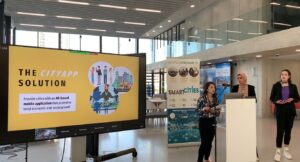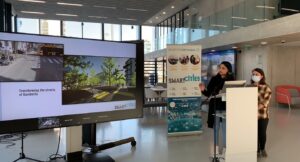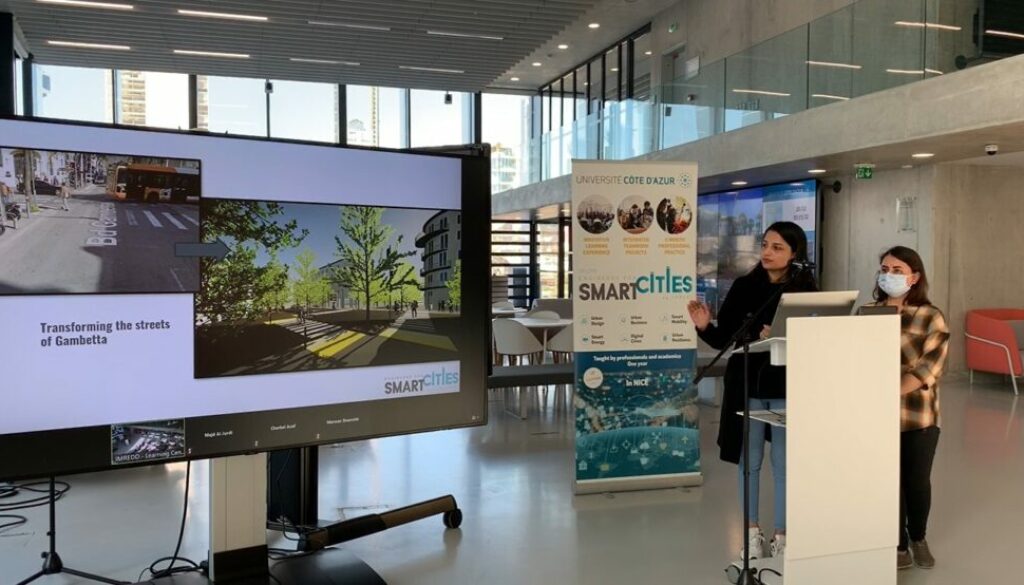Presentation of the Hands-on Projects 2021-22
The Program’s last module Hands-on Integrated Project gives students the opportunity to work throughout the first semester on real and applied projects related to smart cities and sustainable development.
The main goal of this module is the application of the theory and knowledge gained during the lectures and seminars to a hands-on case study.
On February 28th 2022, the presentation of the projects took place in the Learning Center of IMREDD.
The 2021-22 MSc class worked on the following topics:
1) Blue Tech Innovation : reconstructing marine ecosystems using 3D-printed reefs.
2) IoT Innovative Solutions to Smarten a City: CityApp – an AR-based mobile application promoting local economic and social growth.
3) Energy Exchange : a community platform promoting renewable energy and dynamic electricity pricing for electric vehicles.
4) Energy Mapping : assess Nice’s readiness for the transition towards electric mobility.
5) Justice : promoting inclusivity through accessibility.
Blue Tech Innovation : reconstructing marine ecosystems using 3D-printed reefs
Seawalls are protective waterfront structures with the main function of protecting coastline from erosion caused by sea waves. There are many types of seawall structures that are used around the world, which may be categorized as massive gravity type walls, tie walls using steel, concrete or timber piling, rubble mounds, reinforced soil retaining walls, etc.
One possible method to create a colonization site is to modify the seawall by adding 3D printed models. These models could have specific shape and porosity according to the species targeted for the colonization. Research projects already exist in the world and it is important to study the possibilities to apply that on the Côte d’Azur coastline.
IoT Innovative Solutions to Smarten a City: CityApp – an AR-based mobile application promoting local economic and social growth
Governments are pivotal to facilitating economic growth and sustainable transition within their domains. Amidst global challenges with consequent technological, social, and environmental limitations, cities require smart solutions. CityApp is a mobile application that aims to provide a smart city solution that promotes the local economy by improving public engagement with existing city offerings leveraging augmented reality (AR) technology and data collected can be used to empower cities for future decision making.
CityApp seeks to provide municipalities with a smart city solution that promotes local economic and social growth by enhancing public engagement with existing cities’ offerings and providing cities with a method of collecting public utilization and mobility data to support future urban planning.
Energy Exchange : a community platform promoting renewable energy and dynamic electricity pricing for electric vehicles
The idea to use the surplus of electricity to charge an autonomous shuttle is not new but if you consider that the autonomous shuttle is V2G (vehicle to grid), things are going to be different. The actual business model around the V2G is not bankable but if you add to a car, the ability to move autonomously, the perspective could be totally different. With this embedded technology, the autonomous shuttle is now able to transport the energy to another place whenever it is needed. We don’t use anymore the distribution network to transport the electricity from a place to another one. Peer to peer energy exchanges are now different, no administrative constraints, you don’t use anymore the electrical network. Students worked on this “double” use (mobility and energy) of the autonomous shuttle and V2G car, trying to show if there is an interest in our future cities for such scenario.
Energy Mapping : assess Nice’s readiness for the transition towards electric mobility
The integration of electric vehicles in our cities is a very difficult process. Electricity grids would need significant reinforcement to support a shift to electric mobility, which would come at a high cost. Communities and grid operators need to determine which areas should be prioritized for reinforcement. The goal of the project is to provide Nice mapping that indicate the level of readiness of each area for the transition to electric mobility. For example, an area with a poorly equipped electric grid but a large proportion of individual cars may not be ready for electric vehicles. Similarly, given that 80% of electric vehicle charging occurs at home, it is necessary to ensure that every electric car will be able to charge at home.
Justice : promoting inclusivity through accessibility
In every city, various segments of the population, facing hurdles in their mobility, struggle to achieve a daily program of vital and rational activities. Several barriers can be identified with various impacts on inclusion: socio-economic gaps, digital divide, remote, isolated or discriminated neighborhoods, physical disabilities, as well with all the socio-cognitive barriers related to age, gender or other individual components. The social groups suffering from this resentment are a relevant population to study in order to understand and analyze existing injustices in city infrastructure. Students aimed to build a methodology for evaluating differences in accessibility for different social groups: disabled, blind and visually impaired, elderly and socially underprivileged people in the city of Nice.







